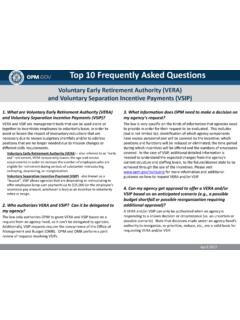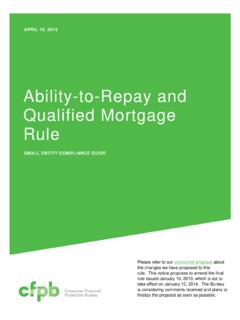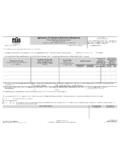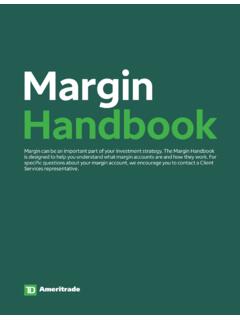Transcription of Section F. Borrower Qualifying Ratios Overview
1 HUD Chapter 4, Section F. Section F. Borrower Qualifying Ratios Overview In This Section This Section contains the topics listed in the table below. Topic Topic Name See Page 1 General Information on Borrower Qualifying 4-F-2. 2 Qualifying Ratios 4-F-3. 3 Compensating Factors 4-F-6. 4-F-1. Chapter 4, Section F HUD 1. General Information on Borrower Qualifying Introduction This topic contains general information on Qualifying a Borrower , including lender responsibility when Qualifying a Borrower , and the importance of careful underwriting analysis. Change Date March 1, 2011. The lender is responsible for adequately analyzing the probability that a Lender Borrower will be able to repay the mortgage obligation according to the terms Responsibility of the loan. When Qualifying a This responsibility includes using Qualifying Ratios and compensating factors Borrower when Qualifying a Borrower .
2 Qualifying Ratios can be exceeded when significant compensating factors exist. Underwriting requires a careful analysis of many aspects of the mortgage. Importance of Careful Each loan is a separate and unique transaction, and there may be multiple Underwriting factors that demonstrate a Borrower 's ability and willingness to make timely Analysis mortgage payments. Simply establishing that a loan transaction meets minimal standards does not necessarily constitute prudent underwriting. When Qualifying a Borrower , it is important to avoid the danger of layering flexibilities when assessing the mortgage insurance risk. 4-F-2. HUD Chapter 4, Section F. 2. Qualifying Ratios Introduction This topic contains information on determining Ratios to qualify a Borrower , including general information about Qualifying Ratios mortgage payment expense to effective income ratio total fixed payments to effective income ratio, and estimating real estate taxes when determining Qualifying Ratios .
3 Change Date March 1, 2011. Qualifying Ratios are used to determine if the Borrower can reasonably be General expected to meet the expenses involved in home ownership, and provide for Information his/her family. In order to make this determination, the lender must calculate About Qualifying the Mortgage Payment Expense to Effective Income ratio, as described in Ratios HUD , and the Total Fixed Payment to Effective Income ratio, as described in HUD. Note: The underwriter must calculate the Qualifying Ratios for entry into the Automated Underwriting System (AUS) in order to be evaluated by the Technology Open To Approved Lenders (TOTAL) Scorecard. Continued on next page 4-F-3. Chapter 4, Section F HUD 2. Qualifying Ratios , Continued The relationship of the mortgage payment to income is considered acceptable Mortgage if the total mortgage payment does not exceed 31% of the gross effective Payment income.
4 Expense to Effective A ratio exceeding 31% may be acceptable only if significant compensating Income Ratio factors, as discussed in HUD , are documented and recorded on Form HUD-92900-LT, FHA Loan Underwriting and Transmittal Summary. For those borrowers who qualify under FHA's Energy Efficient Homes (EEH), the ratio is set at 33%. Note: The total mortgage payment includes principal and interest escrow deposits for real estate taxes hazard insurance mortgage insurance premium homeowners' association dues ground rent special assessments, and payments for any acceptable secondary financing. The relationship of total obligations to income is considered acceptable if the Total Fixed total mortgage payment and all recurring monthly obligations do not exceed Payments to 43% of the gross effective income. Effective Income Ratio A ratio exceeding 43% may be acceptable only if significant compensating factors, as discussed in HUD , are documented and recorded on Form HUD-92900-LT, FHA Loan Underwriting and Transmittal Summary.
5 For those borrowers who qualify under FHA's EEH, the ratio is set at 45%. Continued on next page 4-F-4. HUD Chapter 4, Section F. 2. Qualifying Ratios , Continued For real estate taxes, lenders must use accurate estimates of monthly property Estimating Real tax escrows when Qualifying borrowers. In new construction cases, property Estate Taxes tax estimates must be based on the land and completed improvements, not When just on the land value. Determining Qualifying Reference: For information on projecting and collecting real estate tax Ratios payments, see HUD 4-F-5. Chapter 4, Section F HUD 3. Compensating Factors Introduction This topic contains information on using compensating factors to qualify a Borrower , including documenting compensating factors, and compensating factors benchmark guidelines. Change Date March 1, 2011. Compensating factors used to justify approval of mortgage loans with Ratios Documenting that exceed benchmark guidelines must be recorded on the Underwriter Compensating Comments Section of Form HUD-92900-LT, FHA Loan Underwriting, and Factors Transmittal Summary.
6 Any compensating factor used to justify mortgage approval must also be supported by documentation. TOTAL Scorecard Accept Recommendation The Technology Open To Approved Lenders (TOTAL) Scorecard Accept recommendation does not require documented compensating factors, even if Qualifying Ratios have exceeded FHA benchmark guidelines. Reference: For more information on the TOTAL Scorecard recommendations, see the TOTAL Mortgage Scorecard User Guide. The table below describes the compensating factors that may be used to Compensating justify approval of mortgage loans with Ratios that exceed FHA benchmark Factors guidelines. Benchmark Guidelines Compensating Factor Guideline Description Housing Expense Payments The Borrower has successfully demonstrated the ability to pay housing expenses greater than or equal to the proposed monthly housing expenses for the new mortgage over the past 12-24.
7 Months. Continued on next page 4-F-6. HUD Chapter 4, Section F. 3. Compensating Factors, Continued Compensating Factors Benchmark Guidelines (continued). Compensating Factor Guideline Description Down Payment The Borrower makes a large down payment of 10% or higher toward the purchase of the property. Accumulated Savings The Borrower has demonstrated an ability to accumulate savings, and a conservative attitude toward using credit. Previous Credit History A Borrower 's previous credit history shows that he/she has the ability to devote a greater portion of income to housing expenses. Compensation or Income The Borrower receives documented compensation or income Not Reflected in Effective that is not reflected in effective income, but directly affects Income his/her ability to pay the mortgage. This type of income includes food stamps and similar public benefits. Minimal Housing Expense There is only a minimal increase in the Borrower 's housing Increase expense.
8 Continued on next page 4-F-7. Chapter 4, Section F HUD 3. Compensating Factors, Continued Compensating Factors Benchmark Guidelines (continued). Compensating Factor Guideline Description Substantial Cash Reserves The Borrower has substantial documented cash reserves (at least three months worth) after closing. The lender must judge if the substantial cash reserve asset is liquid or readily convertible to cash, and can be done so absent retirement or job termination, when determining if the asset can be included as cash reserves, or cash to close. Funds and/or assets that are not to be considered as cash reserves include equity in other properties, and proceeds from a cash-out refinance. The lender may use a portion of a Borrower 's retirement account, subject to the following conditions. To account for withdrawal penalties and taxes, only 60% of the vested amount of the account may be used.
9 The lender must document the existence of the account with the most recent depository or brokerage account statement. In addition, evidence must be provided that the retirement account allows for withdrawals under conditions other than in connection with the Borrower 's employment termination, retirement, or death. If withdrawals can only be made under these circumstances, the retirement account may not be included as cash reserves. If any of these funds are also to be used for loan settlement, that amount must be subtracted from the amount included as cash reserves. Similarly, any gift funds that remain in the Borrower 's account following loan closing, subject to proper documentation, may be considered as cash. Note: Reserves from retirement accounts and gifts as described above may be considered as cash reserves when scoring the mortgage application through TOTAL. Reference: For information on acceptable sources of cash reserve funding, see HUD Continued on next page 4-F-8.
10 HUD Chapter 4, Section F. 3. Compensating Factors, Continued Compensating Factors Benchmark Guidelines (continued). Compensating Factor Guideline Description Substantial Non-Taxable The Borrower has substantial non-taxable income. Income Note: This applies if no adjustment was previously made when computing Ratios . Potential for Increased The Borrower has a potential for increased earnings, as Earnings indicated by job training or education in his/her profession. Primary Wage-Earner The home is being purchased because the primary wage-earner Relocation is relocating, and the secondary wage-earner has an established employment history is expected to return to work, and has reasonable prospects for securing employment in a similar occupation in the new area. Note: The underwriter must document the availability of the potential employment. 4-F-9.















